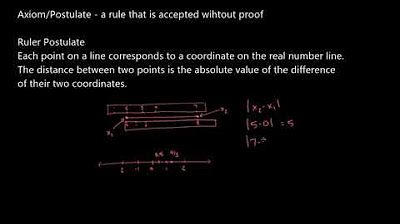The History of Non-Euclidean Geometry - The Great Quest - Part 2 - Extra History
Summary
TLDRThe script explores the legacy of Euclid's geometry and the challenges posed by Postulate 5, tracing its journey through history. Following the fall of the Western Roman Empire, the Byzantine Empire preserved this knowledge, while the Islamic Golden Age saw scholars like al-Khwarizmi and Omar Khayyam make significant advancements in mathematics. Their attempts to resolve Postulate 5 laid groundwork for later developments in non-Euclidean geometry. The story culminates with English scholar Adelard's translations that reintroduced Euclid's Elements to Europe, influencing Renaissance thought and mathematics.
Takeaways
- 📝 Proclus discovered a false solution to Euclid's Postulate 5, sparking centuries of mathematical inquiry.
- ⚔️ The fall of Western Rome led to the loss of many educational texts, including Euclid's Elements.
- 📜 The Byzantine Empire preserved ancient knowledge, serving as a shield for Europe during its collapse.
- 🌍 The Islamic Golden Age saw scholars translating and building upon ancient texts, including Euclid.
- 🔢 Omar Khayyam advanced number theory by integrating irrational numbers into the number line.
- 📚 al-Khwarizmi, a prominent mathematician, contributed to algebra and utilized Euclidean geometry in his work.
- 📏 al-Khwarizmi's geometric method for solving quadratic equations highlights the mathematical techniques of his time.
- 🧐 Many Islamic mathematicians, including Khayyam, attempted to solve Postulate 5 but ultimately failed.
- 📈 Islamic geometers made significant advancements that laid the groundwork for non-Euclidean geometry.
- 🚀 Adelard's translations of Islamic mathematical texts reintroduced Euclid's Elements to Europe, influencing future generations.
Q & A
What was Proclus's monumental discovery regarding Euclid's Postulate 5?
-Proclus discovered that the solution to Euclid's Postulate 5 provided by Ptolemy was false, and he attempted to find a correct solution himself.
How did the fall of Western Rome impact the preservation of mathematical knowledge?
-With the collapse of Western Rome, many institutions, including the educational system, disappeared, leading to the loss of old ideas and texts, including Euclid's Elements.
What role did the Byzantine Empire play in preserving ancient knowledge?
-The Byzantine Empire safeguarded ancient knowledge during its decline and acted as a shield for Europe as it began to recover from the fall of Rome.
How did the Islamic Golden Age contribute to the advancement of mathematics?
-During the Islamic Golden Age, scholars and traders translated many works of ancient thought, making significant advancements in mathematics, including the systemization of algebra and exploration of irrational numbers.
What major contribution did Omar Khayyam make to number theory?
-Omar Khayyam significantly advanced number theory by demonstrating that irrational numbers could be placed on the same number line as rational numbers, challenging Euclid's view of them as separate.
What is the origin of the word 'algebra'?
-The term 'algebra' comes from a book written by al-Khwarizmi, who expanded on Euclidean geometry to formulate algebraic concepts.
How did al-Khwarizmi solve quadratic equations differently than modern methods?
-Al-Khwarizmi used a geometric approach to solve equations, constructing shapes and visual representations to find solutions, rather than relying on algebraic formulas.
What challenges did Islamic mathematicians face regarding Euclid's Postulate 5?
-Islamic mathematicians attempted to prove or disprove Euclid's Postulate 5 but were largely unsuccessful, despite making significant advancements in other areas of mathematics.
How did Adelard contribute to the revival of Euclidean mathematics in Europe?
-Adelard traveled through the Crusader states, collected significant works, and translated them, including Euclid's Elements, which became the basis for all Western versions for centuries.
What impact did Adelard's translations have on Renaissance Europe?
-Adelard's translations played a crucial role in reintroducing Euclidean mathematics to Europe, influencing the developments of the Renaissance and the broader mathematical landscape.
Outlines

Dieser Bereich ist nur für Premium-Benutzer verfügbar. Bitte führen Sie ein Upgrade durch, um auf diesen Abschnitt zuzugreifen.
Upgrade durchführenMindmap

Dieser Bereich ist nur für Premium-Benutzer verfügbar. Bitte führen Sie ein Upgrade durch, um auf diesen Abschnitt zuzugreifen.
Upgrade durchführenKeywords

Dieser Bereich ist nur für Premium-Benutzer verfügbar. Bitte führen Sie ein Upgrade durch, um auf diesen Abschnitt zuzugreifen.
Upgrade durchführenHighlights

Dieser Bereich ist nur für Premium-Benutzer verfügbar. Bitte führen Sie ein Upgrade durch, um auf diesen Abschnitt zuzugreifen.
Upgrade durchführenTranscripts

Dieser Bereich ist nur für Premium-Benutzer verfügbar. Bitte führen Sie ein Upgrade durch, um auf diesen Abschnitt zuzugreifen.
Upgrade durchführenWeitere ähnliche Videos ansehen

A Problem with the Parallel Postulate - Numberphile

Los Universos Paralelos Ocultos Vienen de Hace Muchos Años...

The History of Non-Euclidean Geometry - Sacred Geometry - Part 1 - Extra History

Euclid as the father of geometry | Introduction to Euclidean geometry | Geometry | Khan Academy

Ancient China Part One

Geometry Foundations: Understanding Measurements and Congruence
5.0 / 5 (0 votes)
